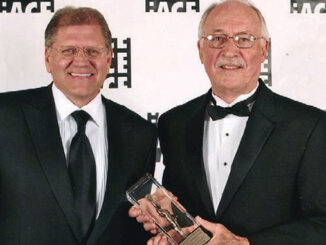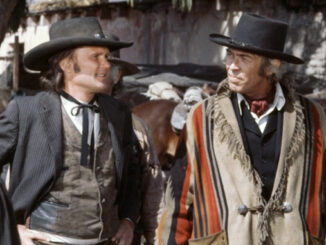
By Patrick Z. McGavin
“I learned about VHS editing in high school,” editor Chris Witt said. “Somebody said: ‘You’re really good at this. You should do this for a living.’
“I thought it’s not a respectable profession. I should be a dentist,” he added.
Fortunately he didn’t listen to that inner voice, and Witt has years later emerged as a versatile, eclectic and in-demand editor.
His newest film is “Breaking,” directed and co-written by Abi Damaris Corbin. It’s a fact-based story about Brian Brown-Easley (John Boyega), a former Marine combat veteran who holds up a bank to protest the government’s withholding of his veteran’s benefits.
The movie premiered in the dramatic competition at the Sundance Film Festival under the title, “892.”
CineMontage: Was your creative dynamic with the director, Abi Damaris Corbin, the same as when you cut her previous short film, “The Suitcase” (2017)?
Chris Witt: We established a shorthand on “The Suitcase.” The bulk of the edit was done over 14 days. We were in the trenches, working really long hours.We made a pact that we would leave no stone unturned. Every frame would count.
There were a lot of parallels when we came to “Breaking.” Not only is the feature a continuation of many of the themes, but we also found ourselves cramped into a tight schedule. As soon as they wrapped picture, we only had six weeks to submit the film for Sundance.
I think it was a relief to both of us that we had done a short film, where we understood what it would take. We knew what our filmmaking language was to get right in there and tell the story as best we could.
CineMontage: Given the fact-based nature of the material, was the cutting influenced by newsreel, or journalistic reportage?
Chris Witt: We had a lot of the actual recordings from the 911 calls. That was used in writing of the script, and John Boyega’s dialect and his mannerism were influenced by that.
I held off for a long time from listening to those recordings because I wanted to remain objective and fresh to it. As we pieced it together, because of how cinematographer Doug Emmett and Abi designed the sequences, I had that vision myself. When our producer Kevin Turen watched the first cut, he said: “It feels like real time.”
I think the truth of what Kevin was saying is the audience finds themselves experiencing the movie thematically as though they are there, as if they are a witness to the event.
I leaned into that concept a lot in terms of how I paced it, creating rhythms that attempted to line up in a psychological way with where the characters are themselves. I accelerated when the character’s heart was racing. I also allowed moments to hold.
CineMontage: Did you want to contrast the movement and tempo of what goes on inside and outside the bank?
Chris Witt: I feel like one of the challenges we had early in the edit was we had these sequences where the design gives a pressure-release to the intensity inside the bank. Like the first time we left the bank and went to the house of Cassandra (Olivia Washington), who’s talking on the phone, and there used to be this long pan across the room. We stayed with Cassandra for that entire phone call. The initial hope was it would allow the audience time to rest and breathe so they could increase the intensity later.
Brian became such a magnetic element of our movie that we had this sense of concentrating on what he was doing. When our producers saw the early cuts, they said, “I want to get back to Brian sooner.” We found ourselves extending Brian everywhere we could.
I would dig into the takes, and just see if there was another beat we could extend this. We cut back to Brian more. We would get back into the bank sooner for his side of the conversation. There was this need to be with Brian. That became more about how we were looking at the rhythm and the balance, keeping Brian ever-present.
CineMontage: How did you want to differentiate his interactions with the police negotiator (Michael K. Williams) and the television journalist (Connie Britton)?
Chris Witt: After Sundance, the distributor Bleeker was very kind to give us one more week. We felt there was a pacing issue. What we did that is different in the theatrical cut is this idea, “Something, something, intercut.”
When it feels like it is just one thing after another, one thing that helps is to see if there is a way to combine two separate things in a more complicated and enriched way.
In the Sundance version, Brian gets tired of things happening so he calls the journalist to give his backstory. Finally he breaks because he realizes she is leading him on for her gain. Then the negotiator comes, and Connie’s character is left behind. We are left in the space of Michael K. Williams’ character.
What we did during the spring was we brought in Michael K. Williams before the call to Connie. When we bring in Connie, we have Michael’s character eavesdrop on a conversation with Connie. From that perspective, Brian sees Connie is unraveling the situation. I think it’s tighter and flows with more interest.
CineMontage: How would you describe your approach to shaping actors’ performances?
Chris Witt: With John Boyega, it was very interesting watching him and Abi working together. From the beginning, when they say action to cut, Boyega was consistently on fire.
You could feel his performance in your bones. When you’re crafting that, you are often very conscious of which part is going to translate from being there in person or what is going to translate on the screen. You’re trying to be very mindful of how those nuances lead to an emotional payoff without stepping on it. That’s where the challenge was.
CineMontage: How did you become an editor?
Chris Witt: I was born and grew up in Wichita, Kansas. I got the film bug when I was about 12. It was a common story, the kid finds high-8 camera, and starts making movies. I took over my dad’s camera, and started making “Saturday Night Live” skits.
In college, I got a mass communications degree at a small private school, Anderson University, in Indiana. I learned how to do nonlinear editing on a computer. The school had more of a news and documentary discipline. I wore a lot of hats in the Midwest. I would shoot, I would edit, and I would write. I learned how to do nonlinear editing on a computer from my mentor Mark Dawson.
Finally I thought, what if I go make movies in Los Angeles on a national stage?
CineMontage: Did you have a breakthrough, or eureka moment?
I didn’t go to film school, so I didn’t have any networks in the side of the industry I wanted to work in. I walked the streets of Hollywood trying to find a way in. Nobody had anything they would let me in, except for one place, called Address One, based at Raleigh Studios, and run by Virgil and Tess Thompson. I got an opportunity to PA for them. I told them my dream, and I told them I used to edit, and I had done some work on AVID.
They gave me some footage and asked me to cut a test promo. From there, I was cutting promos for them. I got an opportunity to get into the unscripted side of things. At some point, there was a MFA student who was doing his thesis. His mentor, Bruce Block, encouraged him to hire somebody who’d give everything to the project. I cut that thing with my heart and soul. That short went on to be nominated for an Oscar that year.
A couple of years later, as I was cutting unheard of and obscure features, I met Abi, and cut her USC thesis film. Now I just logged my 23rd feature.
CineMontage: What do you think you learned about yourself and your art during this time?
Chris Witt: Because of the way I bootstrapped my career, it has been very wide, eclectic and involved many genres. It’s not about the genre. It’s about the footage speaking to me.
These movies have a personality because nobody expected what they were going to shoot. What comes out is often very different than what they anticipated. When you slow down and listen and watch the footage, it will inspire you and speak to you on how the movie itself seems to want to cut together.
When I do cut unscripted, the rhythm, pace and sequence and cinematic feel that I learned from cutting narrative really speaks to what I do. When I cut a movie, and a scene isn’t working, I have the skills from my unscripted background to look at the footage and think outside the box and look at a scene or the footage in a brand new way because that’s what we do every day.
On “Breaking,” I used every experience and every movie I ever had layered into how I approached that movie. I’m really glad I had all of those movies behind me because I was able to meet the challenge.
Patrick Z. McGavin is a Chicago-based writer and cultural critic. Check out more of his work at “Shadows and Dreams” (https://patrickzmcgavin.substack.com).





